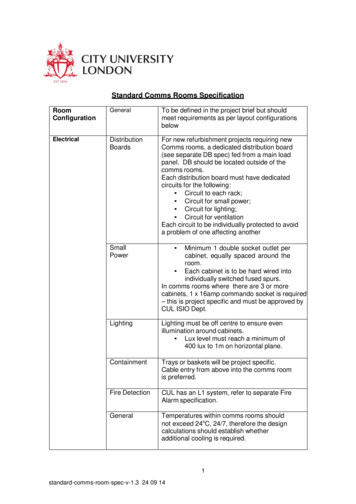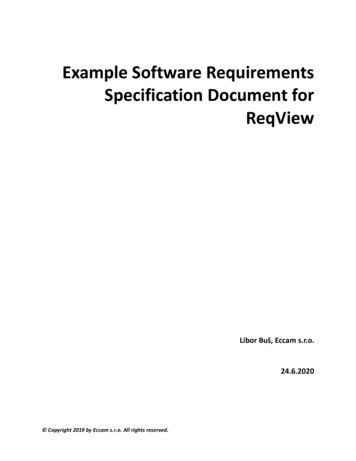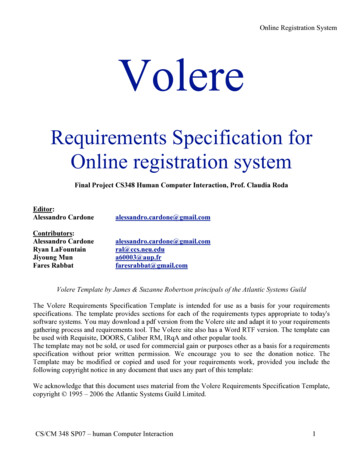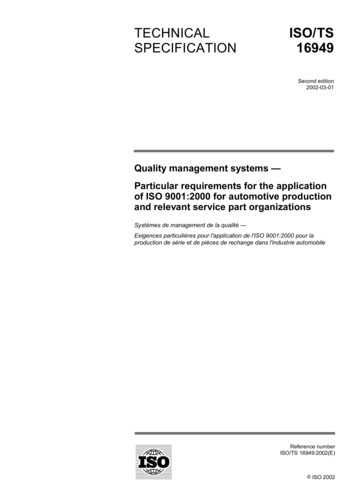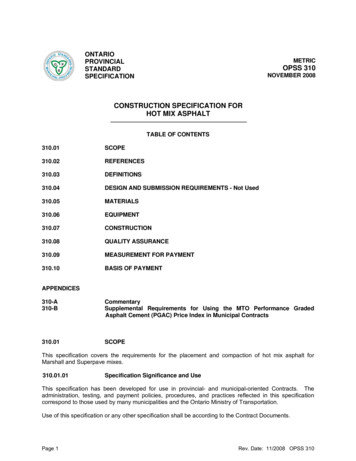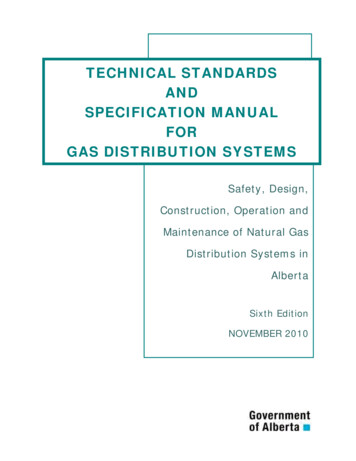
Transcription
CMAA SPECIFICATION NO. 74-2020SPECIFICATIONS FOR TOP RUNNING AND UNDER RUNNING SINGLE GIRDERELECTRIC TRAVELING CRANES UTILIZING UNDER RUNNING TROLLEY HOISTINTRODUCTIONThis Specification has been developed by the Crane Manufacturers Association of America, Inc. (CMAA), an organizationof leading electric overhead traveling crane manufacturers in the United States, for the purpose of promotingstandardization and providing a basis for equipment selection. The use of this Specification should not limit the ingenuityof the individual manufacturer but should provide guidelines for technical procedure.In addition to Specifications, the publication contains information which could be helpful to the purchasers and users ofcranes and to the engineering and architectural professions. While much of this information must be of a general nature,it may be checked with individual manufacturers, and comparisons may be made, leading to the selection of the properequipment.These Specifications consist of nine Sections, as follows:74–1General Specifications74–2Crane Classification74–3Structural Design74–4Mechanical Design74–5Electrical Equipment74–6Inquiry Data Sheet and Speeds74–7Appendix74–8Glossary74–9IndexNo part of these Specifications may be reproduced in any formwithout the prior written permission of CMAA.Copyright 2020 by Crane Manufacturers Association of America, Inc. All rights reserved.1st Printing: November 20202nd Printing:3rd Printing:CMAA SPECIFICATION 74-20201
DISCLAIMERS AND INDEMNITYCRANE MANUFACTURERS ASSOCIATION OF AMERICA, INC. (CMAA)The Crane Manufacturers Association of America, Inc. (CMAA) is an independent incorporated trade association affiliatedwith MHI.MHI provides CMAA with certain services and specifically in connection with these Specifications, arranges for theirproduction and distribution. Neither MHI, its officers, directors or employees have any other participation in the developmentand preparation of the information contained in the Specifications.All inquiries concerning these Specifications should be directed in writing to the Vice President of the CMAA EngineeringCommittee, c/o Crane Manufacturers Association of America, Inc., 8720 Red Oak Blvd., Suite 201, Charlotte, NC 28217. Fora response to technical questions, use the CMAA web site www.mhi.org/cmaa or write directly to the CMAA EngineeringCommittee at the above address.SPECIFICATIONSUsers of these Specifications must rely on their own engineers/designers or a manufacturer representative to specify ordesign applications or uses. These Specifications are offered as information and guidelines which a user may or may notchoose to adopt, modify or reject. If a user refers to, or otherwise employs, all or any part of these Specifications, the user isagreeing to the following terms of indemnity, warranty disclaimer, and disclaimer of liability.The use of these Specifications is permissive and advisory only and not mandatory. Voluntary use is within the control anddiscretion of the user and is not intended to, and does not in any way limit the ingenuity, responsibility or prerogative ofindividual manufacturers to design or produce electric overhead traveling cranes which do not comply with theseSpecifications. CMAA has no legal authority to require or enforce compliance with these Specifications. These advisorySpecifications provide technical guidelines for the user to specify an application. Following these Specifications does notassure compliance with applicable federal, state, and local laws or regulations and codes. These Specifications are notbinding on any person and do not have the effect of law.CMAA and MHI do not approve, rate, or endorse these Specifications. They do not take any position regarding any patentrights or copyrights which could be asserted with regard to these Specifications and do not undertake to ensure anyoneusing these Specifications against liability for infringement of any applicable Letters Patent, copyright liability, nor assumeany such liability. Users of these Specifications are expressly advised that determination of the validity of any suchcopyrights, patent rights, and the risk of infringement of such rights is entirely their own responsibility.Caution must be exercised when relying upon other specifications and codes developed by other bodies and incorporated byreference herein since such material may be modified or amended from time to time subsequent to the printing of thisedition. CMAA bears no responsibility for such material other than to refer to it and incorporate it by reference at the time ofthe initial publication of this edition.DISCLAIMERFOREWORD. The following document, which was developed by MHI and CMAA, one of its Industry Groups, is intended toprovide helpful guidance for owners, users, designers, purchasers, specifiers and others who may be involved in materialhandling and supply chain logistics. It is advisory only and should be regarded as one of many tools that its user may or maynot choose to follow, adopt, modify or reject.VOLUNTARY. The use of the information in the following document is completely voluntary. Its existence does not precludeanyone, whether it has approved the brochure or not, from following procedures and assuming responsibilities that do notconform to the contents of this document.DISCLAIMER OF LIABILITY. MHI and CMAA assume no responsibility and disclaim all liability of any kind, howeverarising, as a result of acceptance, use or alleged use of the contents of this document. Anyone using this documentspecifically understands and agrees that MHI, CMAA, their members, officers, agents and employees will not be liable underany legal theory for any action or failure to act with respect to the contents or any activity relating to this document, it beingthe user’s intent and understanding to absolve MHI and CMAA from all liability.DISCLAIMER OF WARRANTY. MHI, CMAA and their members make NO WARRANTIES of any kind, EXPRESS ORIMPLIED, in connection with the information in this document and SPECIFICALLY DENY AND DISCLAIM ALLEXPRESS OR IMPLIED WARRANTIES OF MERCHANTABILITY AND OF FITNESS FOR PARTICULAR PURPOSE.INDEMNIFICATION. By referring to or otherwise using the information in this document, its user agrees to defend, protect,indemnify, and hold MHI, CMAA, their members, officers, agents, and employees harmless from and against all claims,losses, expenses, damages and liabilities, direct, incidental, or consequential, arising from acceptance or use or alleged useof this document including loss of profits and reasonable attorneys' fees which may arise out of the acceptance or use oralleged use of such information. The intent of this Indemnification provision is to absolve and protect MHI, CMAA, theirmembers, officers, agents and employees from any and all loss relating in any way to activities or decisions relating to thecontents of this document including those resulting from the user's own negligence.2CMAA SPECIFICATION NO. 74-2020
SUMMARY OF CHANGES SINCE THE 2015 REVISION OF SPECIFICATION #74Article 1.4.1.1.1, 1.4.1.2.1 .Runway rail cleanlinessTable 1.4.1-1.Modification of runway rail straightness and elevationArticle 1.4.2 .Anchorage / Restraints DevicesArticle 1.5.4, 5.11 .Runway/bridge conductors combined in one articleArticle 1.7 .Revision of sectionArticle 1.7.3 .FEA design statementArticle 3.3.2.5.3 .Addition of in service wind load to collision load caseArticle 3.4.4.3 .Corrected error in formulaArticle 3.4.7 .Addition of load case for fatigueArticle 3.5.1 .Girder proportionsArticle 3.5.5 .Deflection and camberArticle 3.6.4 .End truck deflectionArticle 3.10 .Restraint DevicesArticle 5.2.1.3.1 .Motor design for inverter applicationsArticle 5.5.6 .Dynamic braking resistors in conductive dustArticle 5.4.7.5 .Practices inside enclosures (new)Article 5.4.7.6 .Practices outside enclosures (new)Article 5.4.7.7 .Suppression devices (new)Article 5.5.5 & 5.13.2.Removed duplication and changed textArticle 5.5.6 .Resistors in conductive dust (new)Article 5.6.10 .Modified text (addition of intentional reset)Figures 5.7.3c, 5.8.1, 5.15.6 .Added recommended layouts for cab, pendant and radioArticle 5.9.3.4 .Added text for operation with molten metalArticle 5.11.8 .Conductor Bar Isolation SectionsArticle 5.13.12 .Regenerative power considerationsArticle 5.13.13 .Application of IEEE 519 for cranesArticle 5.15 .Wireless data (new)Article 5.18 .Magnet controls (new)Article 5.19 .Rail clamps (new)Appendix .Added appendix for non-mandatory crane design informationGlossary.AnchorageGlossary.Common mode failureGlossary.Conductive dustGlossary.Critical load dropGlossary.EMCGlossary.EMIGlossary.Hazardous locationsGlossary.Intentional resetGlossary.MagnetGlossary.Magnet controllerGlossary.Plain Reversing Control changed for Reversing ControlGlossary.Regenerative power ied Undervoltage Protection definitionCMAA SPECIFICATION 74-20203
CMAA SPECIFICATION INTERPRETATION REQUEST PROCEDUREA request for interpretation of CMAA’s specifications is to be designated as an “Action Alert Inquiry.”Only written inquiries about interpretations and the applicability of CMAA Specifications 74 will be given a response bythe CMAA Engineering and Safety Advocacy Workgroup. CMAA does not provide: design guidance, design critique,advice, comments on non-CMAA documents, etc. Inquiries of this nature, if received, will be declined.Send all written requests for interpretation of Specifications 70, 74 and 78, identifying the particular Specification and theSection numbers in question via email to cmaa-info@mhi.org or via Fax to 704-676-1199 to the attention of CMAA.Interpretation requests must identify the sender by name, title, company name, address and telephone number and beon company letterhead. They must also be specific and concise.The following is the CMAA procedure for processing and responding to interpretation requests.1.CMAA assigns an Action Alert Inquiry number to each written inquiry.2.CMAA immediately forwards the inquiry to the CMAA Engineering Vice President. Based on the nature andsubstance of the inquiry, the Vice President selects either a non-balloted or balloted response. Non-ballotedresponses generally will be selected for simple obvious replies and for inquiries to be declined. Inquiries forinterpretation of CMAA Specifications 70, 74 and 78 will be balloted.3.Response time for inquiries typically range from one week to one month, if balloted.This Specification is accompanied by explanatory commentaries.The commentaries in this Specification are not a part of the Specification and do not constitute a formal interpretation ofthe Specification (which can be obtained only through requests as indicated above). The commentaries, therefore, solelyreflect the personal opinions of the editor or other contributors and do not necessarily represent the official position ofCMAA or its technical committees.4CMAA SPECIFICATION NO. 74-2020
TABLE OF CONTENTS74-1 GENERAL SPECIFICATIONS . 7SCOPE . 7BUILDING DESIGN CONSIDERATIONS . 9CLEARANCE .
interpretation of CMAA Specifications 70, 74 and 78 will be balloted. 3. Response time for inquiries typically range from one week to one month, if balloted. This Specification is accompanied by explanatory commentaries. The commentaries in this Specificationare not a part of the Specification and donot constitute a formal interpretation of

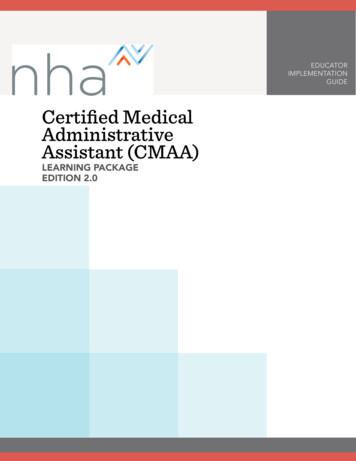
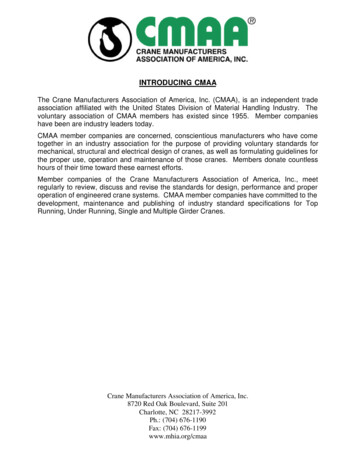

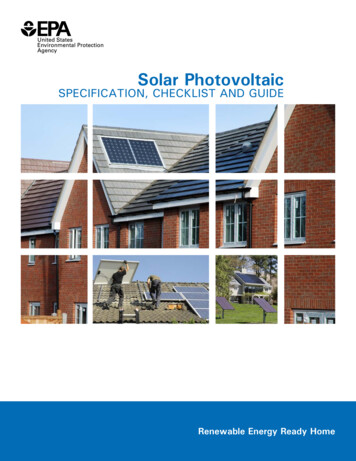
![[MS-ADTS-Diff]: Active Directory Technical Specification](/img/1/ms-adts-170316-diff.jpg)
